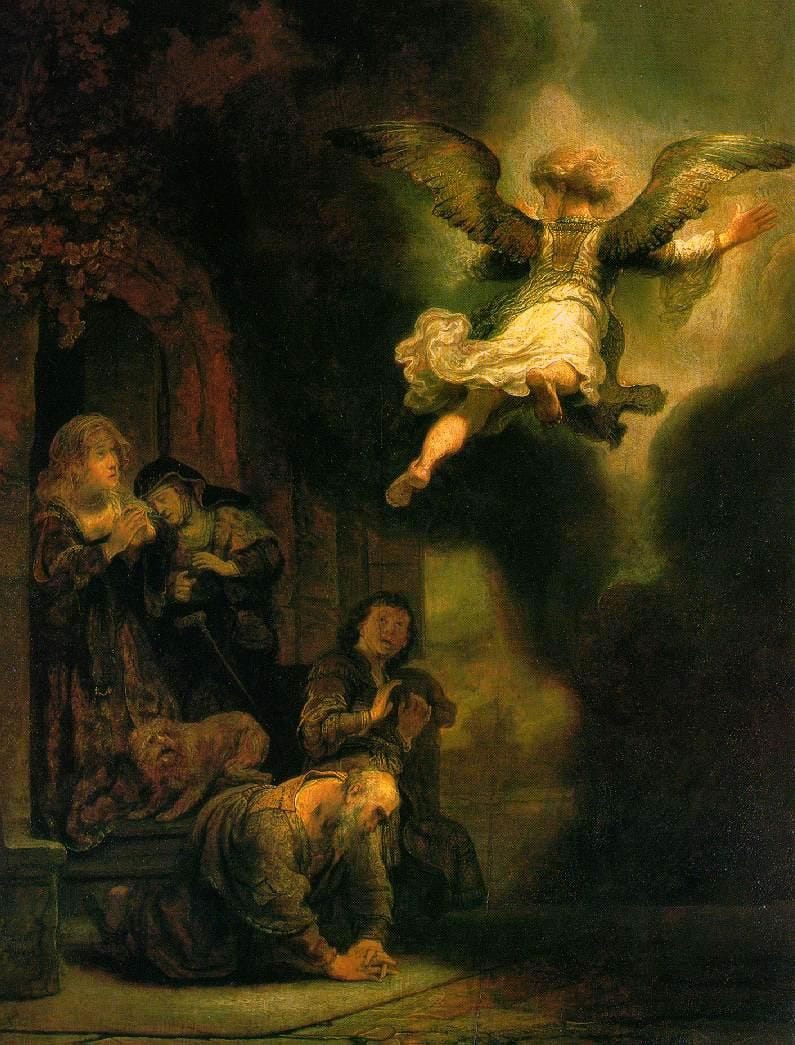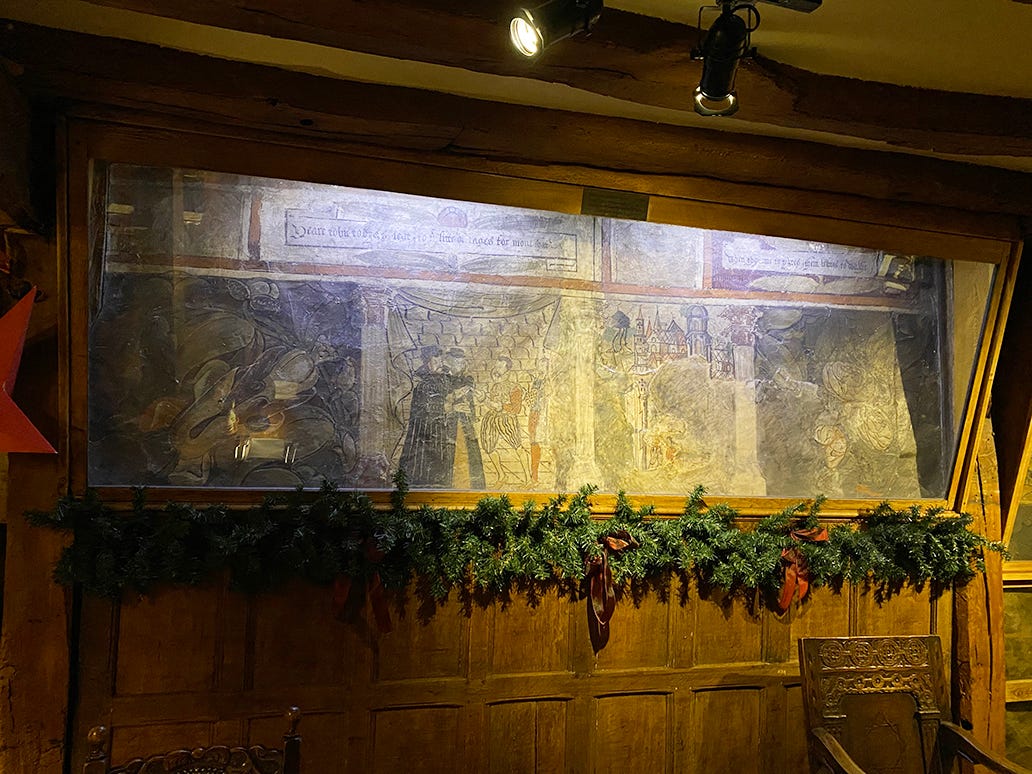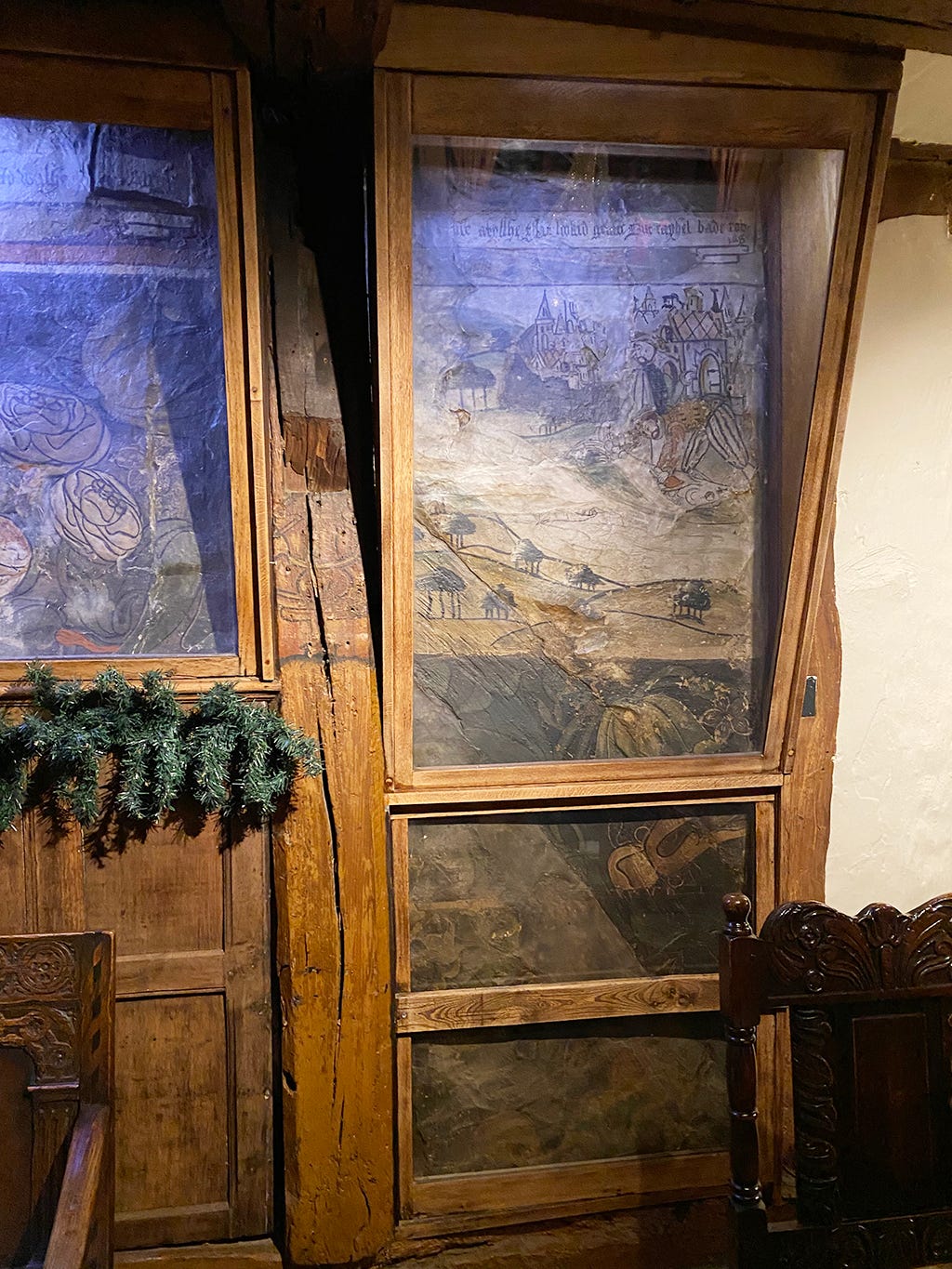
At the end of last year I was reading in Dr Bendor Grosvenor’s excellent new book, The Invention of British Art, about a ‘large (but quite crude) wall painting of Tobias and the Angel at the White Swan Inn at Stratford, dated to early in Elizabeth’s reign’.1 Dr Grosvenor mentioned this in order to demonstrate how, despite the Reformation’s outlawing of ‘idolatrous’ imagery in England, this wall painting shows that the Elizabethans had not expunged Biblical images entirely.
As any historian will tell you, major events - even those as major as the Reformation - rarely burst upon ordinary lives with a force that alters everything overnight. Outward changes were gradual, and inward attitudes were, I suspect, even slower to change. But what really fascinated me about this comment was the fact that I have been going to Stratford-upon-Avon regularly since I was at school and have never heard about or seen this painting. As I was due to see Twelfth Night at the Royal Shakespeare Theatre, I decided to visit the White Swan for a drink.
Firstly, though some background.2 The wall painting was apparently revealed behind some wooden panelling in 1927, during restoration work on the property carried out by the hotel group Trust Houses Limited. The artwork could be dated to the mid-16th-century, which meant that Shakespeare - born around 1564 - might have seen it. By 1560 the building was an inn known as the King’s House or Hall. It was owned by the Perrot family, and one of Shakespeare’s friends, Richard Tyler, married into this family. The artist Francis W. Reader sketched the painting not long after it was rediscovered (below), and it’s a good job he did because it’s difficult to photograph.

The story which the Perrot family chose to depict is from the Book of Tobit and goes as follows: Tobias (son of Tobit) undertakes a journey to collect some money owing to his blind father. Before setting off, Tobit warns his son not to engage in immoral acts and, above all, to:
… take a wife from among the descendants of your fathers and do not marry a foreign woman, who is not of your father’s tribe; for we are the sons of the prophets. Remember, my son, that Noah, Abraham, Isaac, and Jacob, our fathers of old, all took wives from among their brethren. They were blessed in their children, and their posterity will inherit the land. So now, my son, love your brethren, and in your heart do not disdain your brethren and the sons and daughters of your people by refusing to take a wife for yourself from among them. For in pride there is ruin and great confusion; and in shiftlessness there is loss and great want, because shiftlessness is the mother of famine.
He also instructs his son to:
• not keep the wages of the labourer until the next morning, but pay him on time
• do unto others as he would like them to do unto him
• not succumb to drunkenness
• take heed of the advice of wise men
• praise God at all times and live in dependence upon Him.
With this Polonius-like speech ringing in his ears, Tobias sets off with his dog and a mysterious stranger who has offered to help him on his journey. However, when Tobias stops to wash his feet in a river, he is attacked by a monstrous fish, which he catches and kills. Following the stranger’s instructions, he saves the fish’s heart, liver and gall, which are later used to remove a curse from the woman Tobias wishes to marry and to cure his father’s blindness. Unexpectedly, the mysterious stranger reveals himself to be the Archangel Raphael.
The description of the wall painting in the Victoria County History is as follows:
[It shows] three scenes from the Apocryphal book of Tobit. The larger, 9 ft. 2 in. long and 3 ft. broad from the ceiling to the lower edge, was probably the reredos of a high-backed settle or a buffet. At the top is a 12-in. frieze. Below this it is divided into four bays by fluted classic shafts. The outer bays are filled with rather coarse foliage and flowers. The second bay, which has a kind of raised curtain like a scene at a theatre, shows Tobit and his wife, wearing hats and black mantles, handing a letter or some other object to Tobias, who wears a doublet and striped trunk hose; behind him is a similar figure representing Raphael, half hidden by the drapery. The second scene represents a city with turrets and pinnacles, and the figures of Tobias and Raphael, apparently accompanied by a dog. Much of this scene is destroyed. The frieze above is bordered and divided into long and short panels; the latter contain flowering plants; the longer have scrolls inscribed in black letter describing the scenes. A wall-post divides this part from the next, which is 2 ft. 5 in. wide, and rises from floor to ceiling, crossing a timber-strut: this scene shows the river Tigris with Tobias and Raphael cutting open the fish: in the foreground is a landscape with trees and in the background the gate and buildings of the walled city; part of the scene is destroyed. The scroll above reads: leap [te] a fpsshe that lookid grabe. But raphel bade tobias ... Some of the lines of the paintings appear to have been strengthened in restoration. The wall-post between them, which formerly had a curved brace at the top, is painted with a shaft with capital and base. The post of the original front wall south of the paintings is treated somewhat similarly and that in the opposite wall has a foliage treatment. The decoration evidently was carried all round the chamber and there are said to be some slight remains behind the oak overmantel.3
Of course, this isn’t the only Elizabethan wall painting to survive into our own times. Some were found not too far away in Ledbury, in what is now the Town Council offices on Church Street. More interesting to literary scholars are the panels painted by Lady Drury at Hawstead near Bury St Edmunds in Suffolk (now removed to Christchurch Mansion, part of Ipswich Museum). The panels in ‘Lady Drury's Closet’ date from the early 17th century, and contain a series of emblems (allegorical images with Latin tags) used for private religious meditation. Although they represent archteypes, they bring to mind elements of Shakespeare’s work along with that of John Donne (the Drurys were patrons of the latter).
Yet it’s curous that the Perrot family chose to depict a Biblical tale on their wall, especially in light of the removal of ‘idolatrous’ imagery from England after the death of Elizabeth’s Catholic sister, Mary. Most mentions of the painting, including the White Swan’s website, say that it was commissioned by William Perrot in honour of his wife. You can see from the above quotation that Tobit wished his son to marry one of his own kinsmen and that Tobias is a stolid, reliable sort. This (along with the image of the dog) points to an allegory of Christian loyalty, while its narrative quality presumably meant it was not categorised as an image for worship.
It’s my guess that, even within ten years, the painting was an embarrassment to the Perrots - not because it was idolatrous, but because the Book of Tobit was relegated to the Apocrypha (i.e., not part of the accepted canon of scripture as far as Protestants were concerned). This process began around the early 1570s, when Calvinists identified ‘popish abuses’ in the Book of Common Prayer. In the late 1580s, the academic John Rainolds frequently spoke at Oxford about the Apocrypha, and his lectures (published posthumously in 1611) encouraged a distaste for stories such as Tobias and the Angel. The presence of Tobias’s dog, together with the exorcism of an evil spirit by burning a fish’s innards, added to idea that the Apocrypha was full of ‘shameful lies, horrible blasphemies, vain vanities, plain contradictions, ridiculous fooleries’.4
We know the painting was ultimately covered up, but I wonder if that happened within Shakespeare’s lifetime - could this be why so much of it survived? Below are my inadequate photos from the White Swan (whose owners had clearly decked the halls in time for Christmas). I would love to know what you think.

Bendor Grosvenor, The Invention of British Art (London: Elliott and Thompson, 2024), p. 149.
I’m indebted to The Shakespeare Blog for this information.
'The borough of Stratford-upon-Avon: Introduction and architectural description', in A History of the County of Warwick: Volume 3, Barlichway Hundred, ed. Philip Styles (London, 1945), British History Online https://www-british-history-ac-uk.libproxy.york.ac.uk/vch/warks/vol3/pp221-234 [accessed 13 March 2025].
John Canne quoted in Ariel Hessayon’s The Apocrypha in early modern England – part four.







Really interesting. I must visit that pub next time I'm in Stratford. I was reminded of the wonderful novel by Salley Vickers, "Miss Garnet's Angel", in which the series of paintings of the Tobias story at the Chiesa dell'Angelo Raffaele is a leading motif. Thanks for the history and the photos.
We are looking forward to hearing Bendor at the Literature Festival next week 📚